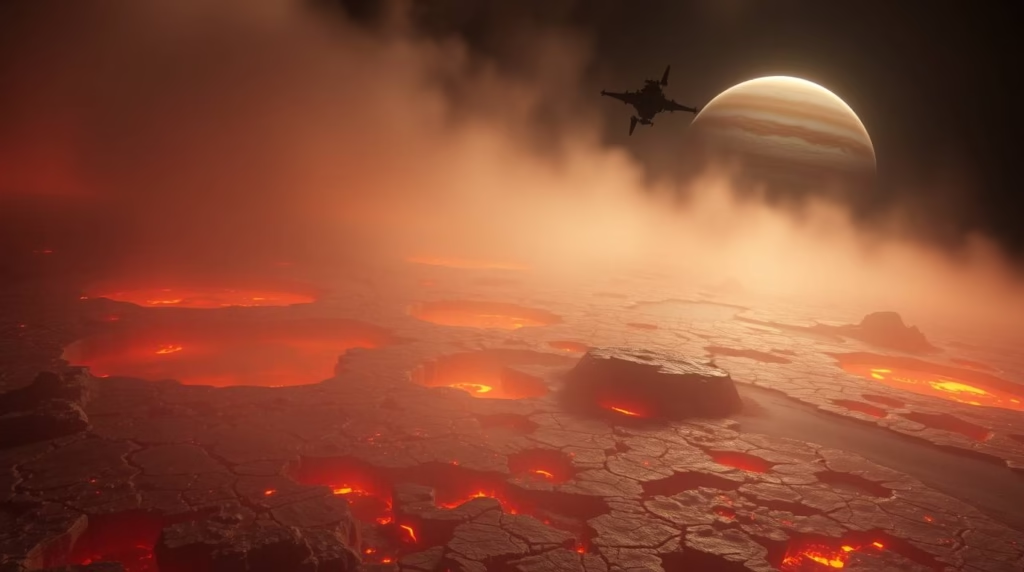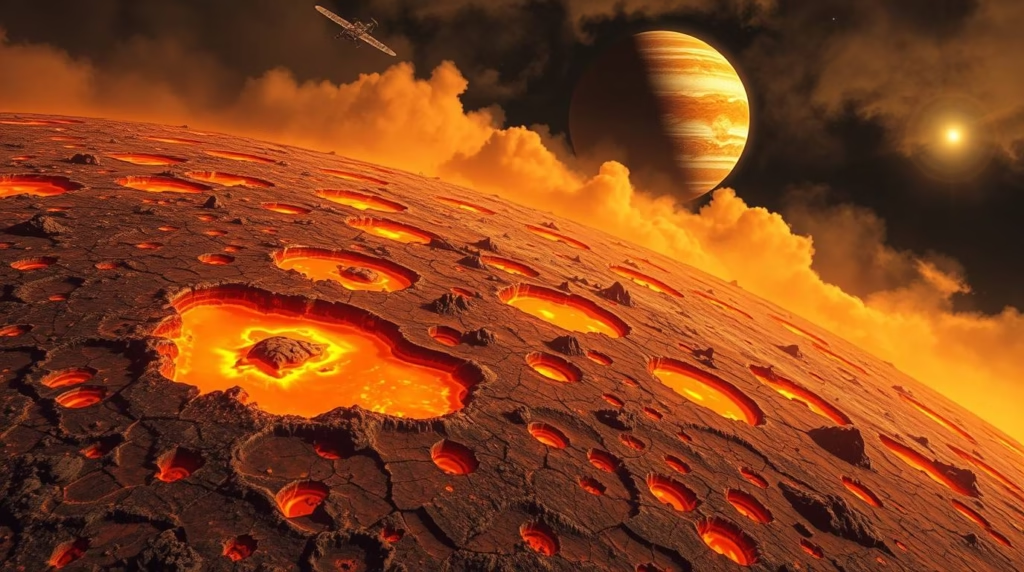Juno’s Dazzling Discoveries: Unraveling Jupiter’s Turbulent Atmosphere and Io’s Volcanic Fury
A Cosmic Powerhouse: Jupiter’s Extreme Nature
Jupiter, the solar system’s colossal gas giant, is a realm of extremes. Its massive polar cyclones, larger than entire continents on Earth, swirl with ferocious intensity. Screaming jet streams carve through its atmosphere, while its moon Io reigns as the most volcanic body in our cosmic neighborhood. Jupiter’s auroras blaze with unmatched brilliance, and its radiation belts unleash a relentless onslaught of energy.According to Scott Bolton, chief investigator on Juno at the Southwest Research Institute in San Antonio, “everything about Jupiter is extreme.” “As Juno’s orbit changes, we’re learning more about the tremendous energy of this gas giant and discovering phenomena that no spacecraft has ever seen before.”
The mission of Juno is a daring attempt to explore Jupiter’s secrets, from its mysterious core to its thick cloud layers. By venturing into uncharted regions, including the planet’s punishing radiation belts, Juno is delivering revelations that captivate scientists and space enthusiasts alike.
Io’s Fiery Heart: A Volcanic Radiator in Space
Juno’s Microwave Radiometer (MWR), originally designed to peer into Jupiter’s deep atmosphere, has turned its gaze toward Io, revealing a world ablaze with volcanic activity. By combining MWR data with infrared imagery from the Jovian Infrared Auroral Mapper (JIRAM), scientists have achieved a remarkable feat: mapping Io’s subsurface temperatures for the first time. According to Shannon Brown, a Juno scientist at NASA’s Jet Propulsion Laboratory in Southern California, “the Juno science team thrives on blending diverse datasets.” “When we paired MWR with JIRAM’s infrared data, we were stunned to find evidence of warm, unsolidified magma lingering beneath Io’s cooled crust.”
According to this ground-breaking discovery, cooling lava flow remnants can be found just beneath the crust of about 10% of Io’s surface. These findings offer vital clues about Io’s rapid surface renewal and the movement of heat from its molten interior to its surface. According to Brown, “Io’s lava fields and volcanoes work like a cosmic radiator.” “They efficiently transfer heat from the moon’s core to its surface, cooling it in the vacuum of space.”
Additionally, JIRAM data revealed the strongest eruption ever witnessed on Io, which was initially noticed during Juno’s flyby on December 27, 2024. As of March 2, 2025, the lava and ash-spouting apocalypse was still active. Scientists expect to see it further during Juno’s flyby on May 6, when the spacecraft will pass within 55,300 miles (89,000 kilometers) of the flaming surface of Io. These close encounters promise to deepen our understanding of Io’s relentless volcanic energy.
Probing Jupiter’s Chilling Polar Realm
On February 18, 2023, Juno began its radio occultation studies, a method that uses radio signals to examine Jupiter’s atmosphere structure, during its 53rd orbit. By transmitting signals from Earth to Juno and back through Jupiter’s atmosphere, scientists measure how the planet’s atmospheric layers bend the waves, yielding precise data on temperature and density.
The first-ever measurement of Jupiter’s north polar stratospheric cap, which was discovered to be 11 degrees Celsius colder than its surroundings, is one of the most remarkable findings. Encircling this frigid zone are winds howling at over 100 miles per hour (161 kilometers per hour). These findings, derived from 26 radio occultation soundings, paint a vivid picture of Jupiter’s dynamic polar atmosphere, offering insights into its complex weather systems.

Dancing Cyclones: Jupiter’s Polar Storms in Motion
Juno’s long-term observations, using its JunoCam visible light imager and JIRAM, have unveiled the mesmerizing dance of Jupiter’s northern polar cyclones. Jupiter’s cyclones originate in close clusters around the north pole, in contrast to Earth’s hurricanes, which form isolated at lower latitudes. The mission has tracked the massive central cyclone and its eight surrounding storms, revealing their unique behavior.
Through a process known as “beta drift”—driven by the interaction between the Coriolis force and the cyclones’ circular wind patterns—these storms gradually migrate toward the pole. Unlike Earth’s hurricanes, which dissipate before reaching polar regions due to insufficient warm, moist air, Jupiter’s cyclones persist in their frigid environment. As they approach the pole, they cluster together, their motion slowing as they interact.
Yohai Kaspi, a Juno co-investigator from the Weizmann Institute of Science in Israel, compares these cyclones to springs in a mechanical system. “This interaction stabilizes their configuration while causing them to oscillate around their central positions, drifting westward in a clockwise motion.” This behavior not only illuminates Jupiter’s atmospheric dynamics but also offers a model for understanding cyclone movements on other planets, including Earth.
Juno’s Perilous Odyssey: A Trailblazer in Hostile Territory
Juno’s ever-changing orbit allows it to explore new vantage points with each science flyby, venturing into regions no spacecraft has dared to go. “Juno’s orbit is a game-changer,” Bolton says. “It takes us through the solar system’s harshest radiation belts, a challenging environment we’ve built Juno to withstand.” Juno, which is shaped like a cosmic tank, withstands extreme radiation while providing unmatched information about Jupiter’s core, magnetic field, and atmosphere.
The spacecraft’s suite of advanced instruments, including the Italian Space Agency-funded JIRAM, enables a collaborative effort involving research institutions across the United States and beyond. Managed by NASA’s Jet Propulsion Laboratory (JPL) in Pasadena, California, and led by Scott Bolton, Juno is part of NASA’s New Frontiers Program, which supports high-priority solar system exploration missions. Built and operated by Lockheed Martin Space in Denver, Juno has been orbiting Jupiter since 2016, braving its extreme conditions to deliver stunning imagery and data.

A New Chapter in Cosmic Exploration
Juno’s latest discoveries mark a thrilling chapter in our quest to understand Jupiter and its volcanic moon, Io. By mapping Io’s subsurface heat and unveiling the intricate dance of Jupiter’s polar cyclones, Juno is reshaping our knowledge of these celestial giants. Its radio occultation experiments have provided unprecedented insights into Jupiter’s atmospheric temperatures, while its daring flybys of Io reveal a world alive with volcanic fury.
As Juno continues its perilous journey, each orbit brings fresh revelations about the solar system’s largest planet and its fiery companion. These findings not only deepen our understanding of Jupiter and Io but also offer valuable lessons for studying atmospheric and volcanic processes across the cosmos. With its next flyby of Io on May 6, 2025, Juno promises to uncover even more secrets, solidifying its legacy as a trailblazer in space exploration.
read more news || click here
